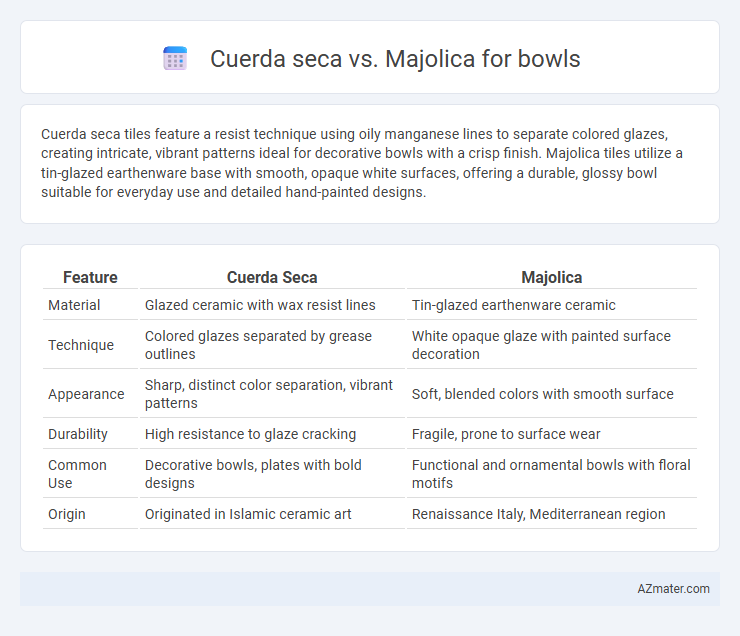Cuerda seca tiles feature a resist technique using oily manganese lines to separate colored glazes, creating intricate, vibrant patterns ideal for decorative bowls with a crisp finish. Majolica tiles utilize a tin-glazed earthenware base with smooth, opaque white surfaces, offering a durable, glossy bowl suitable for everyday use and detailed hand-painted designs.
Table of Comparison
| Feature | Cuerda Seca | Majolica |
|---|---|---|
| Material | Glazed ceramic with wax resist lines | Tin-glazed earthenware ceramic |
| Technique | Colored glazes separated by grease outlines | White opaque glaze with painted surface decoration |
| Appearance | Sharp, distinct color separation, vibrant patterns | Soft, blended colors with smooth surface |
| Durability | High resistance to glaze cracking | Fragile, prone to surface wear |
| Common Use | Decorative bowls, plates with bold designs | Functional and ornamental bowls with floral motifs |
| Origin | Originated in Islamic ceramic art | Renaissance Italy, Mediterranean region |
Introduction to Cuerda Seca and Majolica Techniques
Cuerda Seca and Majolica are two distinctive ceramic glazing techniques used in bowl-making, each creating vibrant, intricate designs. Cuerda Seca involves using a greasy resist line to separate colored glazes, preventing colors from mixing and resulting in sharp, defined patterns often seen in Moorish pottery. Majolica glazing uses a tin-based white opaque glaze as a base, over which colored glazes are applied and fired, producing bright, glossy surfaces with a smooth, painterly quality common in Italian and Spanish ceramics.
Historical Origins of Cuerda Seca and Majolica
Cuerda seca, originating in 10th-century Moorish Spain, employs a resist technique using greasy lines to separate vibrant glazes, which was later transmitted to Mexico by Spanish colonists, blending Islamic and Indigenous influences. Majolica, with roots in Italian Renaissance ceramics, evolved from Hispano-Moresque pottery and became renowned for its tin-glazed, colorful, decorative surfaces during the 15th and 16th centuries, spreading through Europe and the Americas. Both techniques historically signify cross-cultural artistic exchanges, with cuerda seca emphasizing linear outlines and majolica showcasing painterly brushwork on bowl surfaces.
Materials Used in Cuerda Seca vs. Majolica Bowls
Cuerda seca bowls are made using a combination of clay and special mineral-based glazes that are applied in distinct sections separated by a greasy resist line, preventing colors from blending during firing. Majolica bowls utilize a tin-glazed earthenware, where the surface is coated with a white, opaque glaze that provides a smooth base for vibrant, hand-painted designs. The primary material difference lies in cuerda seca's use of resist lines to separate glazes on unglazed clay, whereas majolica relies on a continuous tin glaze layer for decorative painting.
Key Differences in Decorative Processes
Cuerda seca utilizes a resist technique where greasy lines prevent glaze colors from mixing, creating sharp, separated patterns on ceramic bowls. In contrast, Majolica employs a tin-glazed surface painted directly with vibrant, free-flowing designs before firing, resulting in a glossy, unified color finish. The key difference lies in cuerda seca's use of oily lines to divide colors versus Majolica's seamless painted decoration on an opaque white glaze.
Color Palette and Glaze Characteristics
Cuerda seca uses a bold, segmented color palette with distinct, separated glazes that prevent colors from mixing, resulting in sharp, defined patterns ideal for intricate designs on bowls. Majolica features a vibrant, rich color palette achieved through a tin glaze that creates a glossy, smooth surface, allowing colors to blend softly and produce a luminous effect. The glaze on cuerda seca is matte or semi-glossy with a textured finish, while majolica displays a high-gloss, glass-like glaze that enhances the vibrancy and depth of the colors on ceramic bowls.
Durability and Functional Qualities for Bowls
Cuerda seca techniques produce bowls with vibrant, segmented designs but often involve a more porous glaze, which can reduce durability compared to Majolica. Majolica bowls feature a tin-glazed, watertight surface providing superior resistance to scratches, stains, and moisture, making them highly functional for everyday use. The robust glaze of Majolica ensures long-lasting protection and ease of cleaning, ideal for practical kitchenware applications.
Aesthetic Appeal and Design Flexibility
Cuerda seca technique offers vibrant, segmented colors with sharp, defined patterns that emphasize intricate detailing and rich contrasts, ideal for artistic and decorative bowls. Majolica features a smooth, glossy surface with fluid, blended colors, allowing for more painterly and organic designs that enhance naturalistic and expressive aesthetics. Both methods provide unique design flexibility: cuerda seca excels in precise, multicolor patterns while majolica allows for depth and softness in imagery, catering to varied artistic preferences.
Cultural Influences on Bowl Styles
Cuerda seca and Majolica bowl styles reflect distinct cultural influences, with Cuerda seca originating from Islamic pottery traditions characterized by intricate, geometric designs that prevent color bleeding in glazing. Majolica, rooted in Renaissance Italian and Spanish ceramic techniques, features vibrant, hand-painted motifs inspired by nature and mythology, emphasizing colorful, glossy finishes. These cultural legacies shape the visual narratives and craftsmanship methods unique to each bowl style.
Suitability for Contemporary and Traditional Settings
Cuerda seca technique offers bold, vivid patterns with a raised texture ideal for contemporary settings that value striking visual contrast and artistic flair. Majolica glaze provides a smooth, glossy finish with intricate, hand-painted details, perfectly complementing traditional decor's warm and classic aesthetic. Bowls crafted using either method enhance spaces differently: cuerda seca suits modern interiors requiring statement pieces, while majolica aligns with timeless, elegant environments.
Choosing Between Cuerda Seca and Majolica for Bowls
Choosing between cuerda seca and majolica for bowls depends on desired aesthetics and durability; cuerda seca offers intricate, segmented designs with black grease lines separating vibrant glazes, providing sharp contrast and increased control during firing. Majolica features tin-glazed surfaces with smooth, colorful patterns and a glossy finish that enhances food-safe properties but can be more prone to chipping. For decorative bowls requiring detailed patterns, cuerda seca excels, while majolica suits pieces prioritizing a bright, uniform glaze and ease of cleaning.

Infographic: Cuerda seca vs Majolica for Bowl
 azmater.com
azmater.com